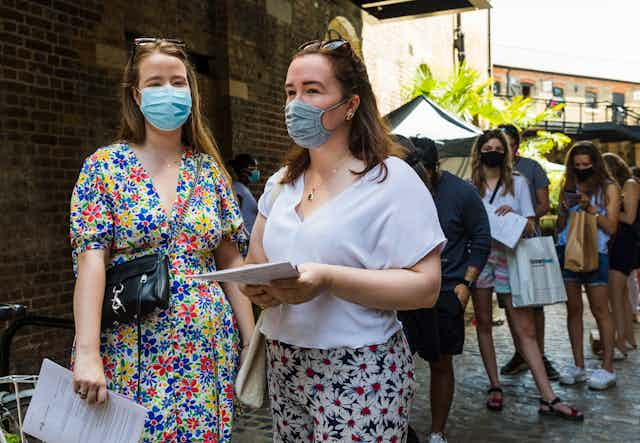After an incredible start, the UK’s vaccination programme is now slowing down. Over 80 million doses have been administered, but more than 10% of the UK adult population still hasn’t been vaccinated. With COVID-19 cases once again rising, the question of how to boost vaccine uptake among the hesitant is a pressing concern.
Previous research suggests that uptake depends on how threatened people feel by the virus, how effective they believe vaccines are in countering this threat, and the risks they associate with vaccination. Of these, “perceived efficacy” – people’s perception of how protective the vaccine is – may be the best predictor of intentions and decisions to take a COVID-19 vaccine, as we know this strongly influences people’s decisions to take flu vaccines.
So if we can highlight to the public just how effective COVID-19 vaccines are, then more people may choose to get vaccinated. But how can we do this?
Making comparisons
Objectively, the COVID-19 vaccines available in the UK work extremely well. The efficacy of the Pfizer/BioNTech and Moderna vaccines – that is, how well they protected people from getting COVID-19 under trial conditions – was 95% and 94% respectively. And in the real world, two doses of either the Pfizer or Oxford/AstraZeneca vaccine are over 90% protective against COVID-related hospitalisation when facing the now dominant delta variant.
Read more: Pfizer vaccine: what an 'efficacy rate above 90%' really means
But it may be important to put this in context for people. These very high numbers can be contrasted with those of more familiar vaccines that have been used for many years. The typical seasonal flu vaccine is estimated to be no more than 60% protective; the mean level of protection offered by the 15 seasonal flu vaccines from 2004-05 to 2018-19 was 40%.

We reasoned that this contrast could be valuable for the way vaccine messaging is presented. Focusing on how well COVID-19 vaccines work, and the context provided by the lower protection offered by the flu vaccine, may produce a “contrast effect”, amplifying the favourable perception of the COVID-19 vaccine.
To test this idea, we began by screening a sample of 2,400 participants to find people who were somewhat vaccine hesitant. Our research was conducted in December 2020, before COVID-19 vaccines were widely available, so we measured people’s intentions rather than their actual behaviour (previous research has found that a person’s vaccination intention is a strong predictor of whether they go on to take a vaccine).
We asked participants to respond to the statement: “I intend to take a COVID-19 vaccine” on a seven-point scale from “strongly disagree” to “strongly agree”. About a quarter of people gave responses in the middle of the scale (“somewhat agree”, “neither agree nor disagree” or “somewhat disagree”). These people are “fence sitters” – unlike anti-vaxxers and COVID-19 deniers, they are concerned about COVID-19 and do not reject all vaccines but remain cautious about COVID-19 vaccines specifically. This group was the focus of our research.
We then recruited 481 people from this vaccine-hesitant group to take part in our experimental survey. Participants were presented with a short text (about 200 words) about COVID-19 vaccines, describing their safety and efficacy and the benefits of widespread uptake. Some participants were presented with extra information that compared the efficacy of the COVID-19 vaccines with the protection offered by the annual flu vaccine. There was also a control group in which participants were not given any information.
After they read the text, we asked: “If you were offered a COVID-19 vaccine tomorrow, how likely is it that you would take the vaccine?” We also asked about their intentions to take the flu vaccine in the future and their perceptions of how well it worked.
Our results showed that vaccination intentions were 20% higher in the group given information about the safety and efficacy of the new COVID-19 vaccines relative to those shown no information. However, the strongest intentions to take the vaccine were found in the group that was also told that on average the flu vaccine is only 40% protective, but “has prevented millions of infections and saved many thousand lives”.
Here the average intention to take a COVID-19 vaccine was 36% higher than among those not shown any information. In other words, putting the efficacy of the COVID-19 vaccines in context worked the way we hoped it would. Importantly, this positive contrast effect for the COVID-19 vaccines didn’t appear to lower people’s intentions to take the flu vaccine.

Vaccine hesitancy is not necessarily irrational. Some people may have reasonable concerns about the remarkable speed at which the COVID-19 vaccines were developed. They may be swayed by reports of a vaccinated person becoming infected, for instance. But such concerns can be addressed by clear, factual messaging.
And part of this messaging could involve explicitly comparing the efficacy of COVID-19 vaccines with the more familiar seasonal flu vaccine, for as we have shown, focusing people’s attention on just how well the COVID-19 vaccines work can raise people’s intentions to get vaccinated.

